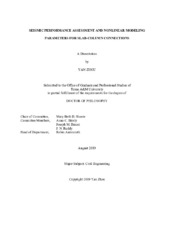| dc.contributor.advisor | Hueste, Mary Beth | |
| dc.creator | Zhou, Yan | |
| dc.date.accessioned | 2019-11-25T23:07:36Z | |
| dc.date.available | 2021-08-01T07:33:37Z | |
| dc.date.created | 2019-08 | |
| dc.date.issued | 2019-07-24 | |
| dc.date.submitted | August 2019 | |
| dc.identifier.uri | https://hdl.handle.net/1969.1/186584 | |
| dc.description.abstract | The two-way shear response of slab-column connections has been evaluated by a significant number of experiments. This research documents an updated database of slab-column (SC) connection tests using consistent criteria for selecting key response parameters including the limiting lateral drift capacity and gravity shear ratio. The updated database confirms that the limiting lateral drift tends to decrease as the gravity shear ratio increases. The ACI 318-14 limiting relationship between the design drift demand and the gravity shear ratio is nearly a lower bound; however, a slightly lower limit is provided as a possible more conservative option for design. The updated database was used to develop new modeling parameters to define the force-deformation backbone relationships for SC connection components. The proposed modeling parameters are the approximate mean values of the data. The proposed acceptance criteria for different performance levels are defined based on the modeling parameter corresponding to initiation of significant strength degradation. When continuity reinforcement is not present, the values of the proposed acceptance criteria tend to be slightly lower than the current ASCE 41-17 acceptance criteria. A nonlinear model monitoring column drift to capture punching shear failure for SC connections was developed to model the lateral load response of SC frames. The comparison between analytical and experimental backbones demonstrates that the flexural strength over the slab column strip provides a reasonable estimate of the experimental results. The proposed nonlinear modeling parameter predicts the approximate mean DR values with respect to the experimental data and is reasonable to model SC connections.
Based on the verified punching shear model and the proposed nonlinear modeling parameters, a four story post-tensioned flat slab building that had punching shear failures during the 1994 Northridge Earthquake is evaluated. Both the proposed and current ASCE 41-17 modeling parameters and acceptance criteria are applied. Both methods indicate that the interior SC frames are prone to damage as they do not meet the basic safety earthquake BSE-2E (collapse prevention performance level for the five percent probability of exceedance in 50 year event). Further, the ASCE 41-17 approach to determine the slab stiffness is appropriate for the building analysis. | en |
| dc.format.mimetype | application/pdf | |
| dc.language.iso | en | |
| dc.subject | Seismic Performance | en |
| dc.subject | Slab-Column Connection | en |
| dc.subject | Reinforced Concrete | en |
| dc.subject | Prestressing Concrete | en |
| dc.subject | Nonlinear Modeling Parameters | en |
| dc.subject | ASCE 41 Approach | en |
| dc.subject | Nonlinear Static and Aynamic Analysis | en |
| dc.title | Seismic Performance Assessment and Nonlinear Modeling Parameters for Slab-Column Connections | en |
| dc.type | Thesis | en |
| thesis.degree.department | Civil and Environmental Engineering | en |
| thesis.degree.discipline | Civil Engineering | en |
| thesis.degree.grantor | Texas A&M University | en |
| thesis.degree.name | Doctor of Philosophy | en |
| thesis.degree.level | Doctoral | en |
| dc.contributor.committeeMember | Birely, Anna | |
| dc.contributor.committeeMember | Bracci, Joseph | |
| dc.contributor.committeeMember | Reddy, J. N. | |
| dc.type.material | text | en |
| dc.date.updated | 2019-11-25T23:07:36Z | |
| local.embargo.terms | 2021-08-01 | |
| local.etdauthor.orcid | 0000-0002-4498-6719 | |


